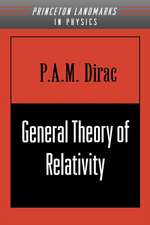Occultations for Probing Atmosphere and Climate
Editat de Gottfried Kirchengast, Ulrich Foelsche, Andrea Steineren Limba Engleză Hardback – 26 aug 2004
| Toate formatele și edițiile | Preț | Express |
|---|---|---|
| Paperback (1) | 1046.87 lei 38-44 zile | |
| Springer Berlin, Heidelberg – 29 noi 2010 | 1046.87 lei 38-44 zile | |
| Hardback (1) | 1230.66 lei 43-57 zile | |
| Springer Berlin, Heidelberg – 26 aug 2004 | 1230.66 lei 43-57 zile |
Preț: 1230.66 lei
Preț vechi: 1500.81 lei
-18% Nou
Puncte Express: 1846
Preț estimativ în valută:
235.56€ • 255.96$ • 197.100£
235.56€ • 255.96$ • 197.100£
Carte tipărită la comandă
Livrare economică 21 aprilie-05 mai
Preluare comenzi: 021 569.72.76
Specificații
ISBN-13: 9783540223504
ISBN-10: 3540223509
Pagini: 420
Ilustrații: X, 408 p. 265 illus., 35 illus. in color.
Dimensiuni: 155 x 235 x 31 mm
Greutate: 0.82 kg
Ediția:2004
Editura: Springer Berlin, Heidelberg
Colecția Springer
Locul publicării:Berlin, Heidelberg, Germany
ISBN-10: 3540223509
Pagini: 420
Ilustrații: X, 408 p. 265 illus., 35 illus. in color.
Dimensiuni: 155 x 235 x 31 mm
Greutate: 0.82 kg
Ediția:2004
Editura: Springer Berlin, Heidelberg
Colecția Springer
Locul publicării:Berlin, Heidelberg, Germany
Public țintă
ResearchDescriere
Use of occultation methodology for observing the Earth's atmosphere and climate has become so broad as to comprise solar, lunar, stellar, navigation and satellite crosslink occultation methods. The atmospheric parameters obtained extend from the fundamental variables temperature, density, pressure, water vapor, and ozone via a multitude of trace gas species to particulate species such as aerosols and cloud liquid water. Ionospheric electron density is sensed as well. The methods all share the key properties of self-calibration, high accuracy and vertical resolution, global coverage, and (if using radio signals) all-weather capability. Occultation data are thus of high value in a wide range of fields including climate monitoring and research, atmospheric physics and chemistry, operational meteorology, and other fields such as space weather and planetary science. This wide area of variants and uses of the occultation method has led to a diversi fication of the occultation-related scientific community into a range of different sub-communities, however. The 1st International Workshop on Occultations for Probing Atmosphere and Cli mate-OPAC-1- held September 16-20, 2002, in Graz, Austria, has set in ex actly at this point. OPAC-1 aimed at providing a casual forum and stimulating at mosphere fertilizing scientific discourse, co-operation initiatives, and mutual learning and support amongst members of all the different sub-communities. The workshop was attended by about 80 participants from 17 different countries who actively contributed to a scientific programme of high quality and to an excellent workshop atmosphere, which was judged by the participants to have fully met the aims expressed.
Cuprins
Occultations for Probing Atmosphere and Climate: Setting the Scene.- 1. Occultation Methodology in General.- Wave Optics Algorithms for Processing Radio Occultation Data in the Lower Troposphere: A Review and Synthesis.- The Radio-Holography Approach for GNSS Occultation Data Analysis: Review and Application to Resolving Fine Structures in the Atmosphere and Mesosphere.- Open Loop Tracking and Inverting GPS Radio Occultation Signals: Simulation Study.- Fourier Analysis of GNSS-LEO Radio Occultation Signals, Resolution and Limitations.- Canonical Transform Methods for Radio Occultation Data.- Unfolding of Radio Occultation Multipath Behavior Using Phase Models.- Abel Integral Inversion in Occultation Measurements.- Does a Priori Information Improve Occultation Measurements?.- Retrieval of Atmospheric Refractivity Profiles from Ground-Based GPS Measurements.- 2. GNSS—LEO Occultation.- GRAS—SAF Radio Occultation Data from EPS/Metop.- Deviations from a Hydrostatic Atmosphere in Radio Occultation Data.- Sensitivity of GNSS Occultation Profiles to Horizontal Variability in the Troposphere: A Simulation Study.- Advancement of GNSS Radio Occultation Retrieval in the Upper Stratosphere.- Ensemble-Based Analysis of Errors in Atmospheric Profiles Retrieved from GNSS Occultation Data.- Refractivity Profiles Obtained by Abel Inversion from a Down Looking GPS Radio Occultation Experiment at Mt. Fuji: Preliminary Results and Future Plan.- 3. LEO—LEO Occultation.- An Active Microwave Limb Sounder for Profiling Water Vapor, Ozone, Temperature, Geopotential, Clouds, Isotopes and Stratospheric Winds.- An Overview of the University of Arizona ATOMS Project.- The ACE+ Mission: An Atmosphere and Climate Explorer Based on GPS, GALILEO, and LEO-LEO Radio Occultation.- Simulating the Influence of Horizontal Gradients on Retrieved Profiles from ATOMS Occultation Measurements — A Promising Approach for Data Assimilation.- Water Vapor Profiling Using Absorptive Occultation Measurements: A Comparison Between SAGE III and ATOMS.- The Genesis of the ACE+ Anti-Rotating Satellites Concept.- 4. Stellar and Solar Occultation.- The Stellar Occultation Technique: Past Achievements, Recent Developments, and Future Challenges.- Envisat/GOMOS Stellar Occultation: Inversion Schemes and First Analyses of Real Data.- Atmospheric Density, Pressure and Temperature Profile Reconstruction from Refractive Angle Measurements in Stellar Occultation.- Stratospheric Temperature and Ozone Sounding with ENVISAT/GOMOS Stellar Occultation.- Information Approach to Channel Selection for Stellar Occultation Measurements.- The Solar Occultation Mission ACE: An Overview.- Mesospheric Temperature and Ozone Sounding by the SMAS Solar Occultation Sensor.- 5. Use of Occultation Data.- Utility of Occultations for Atmospheric Wave Activity Studies: Results of GPS/MET Data Analyses and Future Plan.- Stratospheric Gravity Wave Fluctuations and Sporadic E at Mid-Latitudes with Focus on Possible Effects of the Andes.- The Detection of Upper Level Turbulence via GPS Occultation Methods.- Evaluation of Refractivity Profiles from CHAMP and SAC-C GPS Radio Occultation.- Ionospheric Radio Occultation Measurements and Space Weather.- The Mars Atmospheric Constellation Observatory (MACO) Concept.- Author Index.
Caracteristici
First book to provide a "one stop" insight to occultation science in such a comprehensive manner
Includes supplementary material: sn.pub/extras
Includes supplementary material: sn.pub/extras














